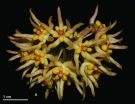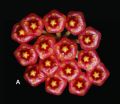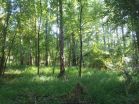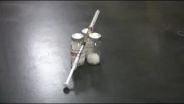Thriving in the tropics of Borneo: 2 new Hoya species on the third largest island
2015-07-21
(Press-News.org) Dr. Michele Rodda describes two new tropical plants species from the Hoya genus, found on the world's third largest island Borneo. The genus is one of the largest and most complex plant groups in Asia. The first to be described in the paper, H. ruthiae, is characterised with its lack of coloured milk-like sap typical for most of the Hoya species, and H. bakoensis - with its strict preference for growing epiphytically (without causing any harm to its host) and rooting inside ant nests. The study is published in the open-access journal PhytoKeys.
Collected by Ruth Kiew in Sabah in 2000, H. ruthiae was named after the tropical botanist based at the Forest Research Institute Malaysia. It grows on limestone with its so far only location being the Malaysian state. Therefore, its conservation status is not yet known and the plant species is categorised as Data Deficient following the IUCN guidelines. However, it is widely available in cultivation.
The second new species, H. bakoensis, was discovered by the author of the present paper in 2015 and was named after its for now sole locality, the Bako National Park in Malaysia. The species prefers moist, shady kerangas heath forests near streams. Most often, it sprouts its seedlings from the openings of small ant nests from inside hollow tree trunks and climbs up its host tree likely in need for more light. Additionally, the author points out that H. bakoensis can be recognised from most of its relatives because of its smaller flowers.
INFORMATION:
Original source:
Rodda M (2015) Two new species of Hoya R.Br. (Apocynaceae, Asclepiadoideae) from Borneo. PhytoKeys 53: 83-93. doi: 10.3897/phytokeys.53.5079
ELSE PRESS RELEASES FROM THIS DATE:
2015-07-21
URBANA, Ill. - Controlled burning is widely used to maintain biodiversity and enhance regeneration of important deciduous tree species such as oak and hickory, but a recent University of Illinois study found that this practice also increases the growth of an aggressive species of invasive grass.
Microstegium vimineum (also called Japanese stiltgrass or Nepalese browntop) is an abundant non-native grass in southern Illinois where the study was conducted.
"We found that fire promotes the recruitment and growth of M. vimineum, particularly under moist soil conditions," ...
2015-07-21
Although much progress has been made in combating the global HIV/AIDS pandemic, to halt new infections and end the pandemic, a combination of non-vaccine and vaccine prevention modalities will be needed. Even with these tools, significant implementation gaps must be closed, including the targeted deployment of proven prevention methods to the populations that need them most, says Anthony S. Fauci, M.D., director of the National Institute of Allergy and Infectious Diseases at the National Institutes of Health. Dr. Fauci addressed a special session at the 8th International ...
2015-07-21
Irvine, Calif., July 21, 2015 - The 11 percent decrease in climate change-causing carbon dioxide emissions in the U.S. between 2007 and 2013 was caused by the global financial recession - not the reduced use of coal, research from the University of California Irvine, the University of Maryland, and the International Institute for Applied Systems Analysis shows.
Experts have assumed that the drop in emissions reflected a shift toward natural gas, which produces roughly half as much carbon dioxide per unit of energy as coal and was made cheap by the hydraulic fracturing ...
2015-07-21
Only one in three older Americans have their diabetes under control as measured by guidelines set by the American Diabetes Association, new Johns Hopkins Bloomberg School of Public Health research suggests.
Some argue that ADA guidelines may be too stringent for some older adults. But even using less stringent measures, the researchers found, there are still many older Americans whose diabetes is not well managed, a condition that can lead to multiple long-term health problems ranging from kidney disease to blindness.
In a report published in the July issue of Diabetes ...
2015-07-21
Most of us think of infants as tiny beings whose main business is to sleep, suck and cry, without much awareness of what is happening around them. It may come as somewhat of a surprise, then, to know that newborn brains are full of feverish activity and that they are already gathering and processing important information from the world around them. At just two days after birth, babies are already able to process language using processes similar to those of adults. SISSA researchers have demonstrated that they are sensitive to the most important parts of words, the edges, ...
2015-07-21
One of the most basic yet important surgical skills to keep a patient alive and intact may be closing wounds. It seems that doctors will now get the job done with more ease thanks to new, nontoxic surgical glue that instantly seals a bleeding wound and helps it heal without a scar or inflammation.
Inspired by nature's wonders, Korean scientists at Pohang University of Science and Technology (POSTECH) have developed a light-activated, mussel protein-based bioadhesive (LAMBA) that works on the same principles as mussels attaching to underwater surfaces and insects maintaining ...
2015-07-21
PROVIDENCE, R.I. [Brown University] -- When the HOPE VI community revitalization project in the disadvantaged Birmingham, Ala., neighborhood of Ensley reached the phase of building walking and biking paths, green spaces, and improved lighting in 2010, two things happened, according to a new study: First, residents developed specific expectations that leisure exercise would become more plausible, and then they followed through and got out there.
Before the neighborhood's revitalization, launched in 2006 with funding from the federal program Housing Opportunities for People ...
2015-07-21
A vaccine that protects against a wide variety of influenza viruses (a so-called universal flu vaccine) is a critical public health goal given the significant rates of illness and death caused by seasonal influenza and the potentially devastating effects of a pandemic influenza strain. Now, researchers from the National Institute of Allergy and Infectious Diseases (NIAID), part of the National Institutes of Health, have devised a way to induce protective immunity in mice against a wide array of influenza viruses.
Instead of trying to predict which influenza virus strains ...
2015-07-21
This news release is available in German. In 2003, Europe experienced a record-breaking summer, and many people feel that this summer is headed the same way. In the midst of this heatwave, the scientific journal Nature Geoscience has published a study that can help us to understand such extreme weather conditions. For around two years, an ETH research team has analysed climate data from all over the world in a bid to explain the driving force behind stable high-pressure systems. It has long been known that extremely stable high-pressure systems in the upper troposphere, ...
2015-07-21
Researchers at the Babraham Institute and Cambridge Systems Biology Centre, University of Cambridge have shown that yeast can modify their genomes to take advantage of an excess of calories in the environment and attain optimal growth.
The ability to sense environmental nutrient availability and act accordingly is a critical process for all organisms. Changing behaviour in response to nutrients can occur at many levels: the activity of proteins can be varied or new genes can be activated to produce a different set of proteins. Research published in the latest issue of ...
LAST 30 PRESS RELEASES:
[Press-News.org] Thriving in the tropics of Borneo: 2 new Hoya species on the third largest island





